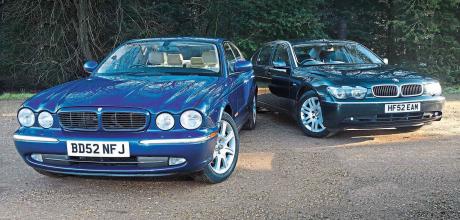2002 BMW 745Li E66 vs. 2003 Jaguar XJ8 Sport 4.2 X350
These two chairmen’s carriages offered what their manufacturers felt was the perfect blend of comfort and technology but achieved their aims in different ways – one favoured evolution, while the other was unashamedly revolutionary. Both are excellent value modern classics today, but one’s just that little bit more captivating. Words Sam Skelton. Photography Paul Walton.
TWIN TEST SEAT OF POWER X350 XJ8 vs BMW745I E65
Which is the best luxury leviathan from the early 2000s; the traditional-looking X350 XJ8 or the more modern E65/66-generation of BMW 7-Series? We drive an early V8-engined example of both to find out.
Technology. Like it or lump it, we all have to endure it in so many different aspects of life. And it’s inevitable that when it comes to cars, the more upmarket and expensive the car, the more technology will be shoehorned into it. The flagships of the BMW and Jaguar ranges are no different, and twenty years ago both took what T was arguably their single biggest step forward. Jaguar’s X350 used clever aluminium construction techniques to reduce weight and add strength, while BMW’s controversial styling and all-encompassing iDrive system brought some serious IT to the highways. But both took these steps in very different ways, ensuring that the plutocrat with pound notes in their pocket had a very difficult decision ahead.
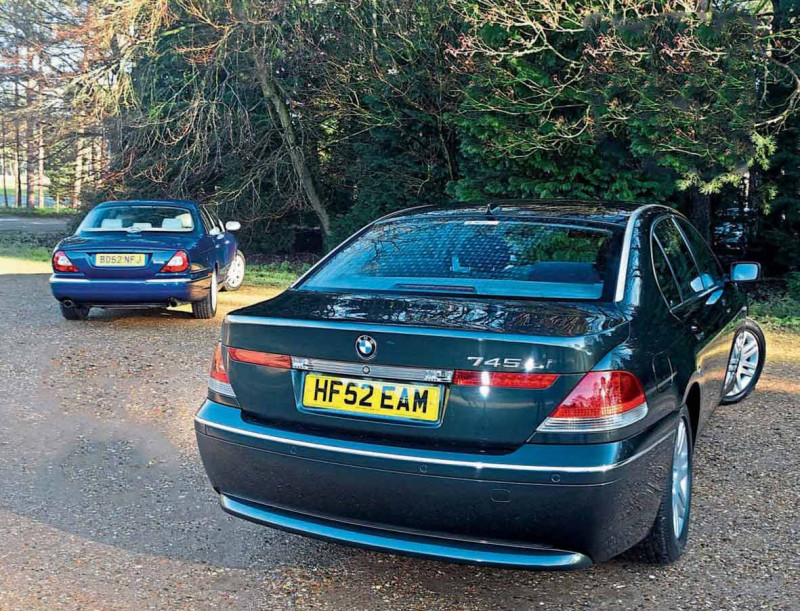
The BMW was the result of five full years of development. In early 1997, controversial design chief Chris Bangle invited BMW’s Munich studio and its Designworks studio in America to tender proposals for the next generation of 7-Series. Twenty designers were invited to take part, and Adrian van Hooydonk’s proposal was approved the following spring. It hadn’t even been his most controversial proposal – initial concepts were centred around a fastback design, something BMW would subsequently return to with the 5-Series GT. It employed what BMW chose to term flame surfacing techniques, offering shapes and angles BMW claimed were reminiscent of gas burning under pressure. It was 1.8in longer than the outgoing model, 1.5in wider, and 2.4in taller – but weighed barely 15kg more than the E38 it replaced when compared spec-for-spec. Inside, there was a convex dashboard for the first time in a BMW – and for the first time since 1975, the centre console wasn’t angled toward the driver. There was an electronic handbrake, and where the gear selector would once have sat was a new computer input for the iDrive system mounted in the dash. iDrive was to be the future of in-car technology – like the subsequent Apple iPhone, it would combine multiple functions in a single device, controlling everything from the air conditioning to the radio through the mouse in the middle and the screen on the dash. Subsequent versions of iDrive would be more intuitive and would incorporate buttons to return to the menu and change the radio station independently of the iDrive system. The resulting E65 7-Series would also employ active anti-roll bars, adaptive cruise control, soft-close doors and two fibreoptic computer networks. It could be specified with internet connectivity from the start and pioneered both the six-speed automatic gearbox and the electronic parking brake. Introduced in September 2001, BMW launched the car in November of the same year and deliveries began in early 2002. The long wheelbase E66 joined the E65 in June 2002, badged Li. Production ceased in 2008.
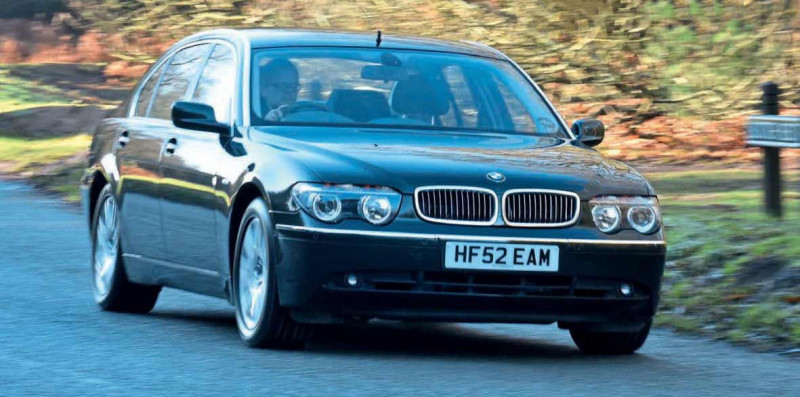
Where the BMW was a revolution, the Jaguar was an evolution of what had come before – but that’s not to say the differences were minor. The shell was some 40 percent lighter spec-for-spec than the outgoing model, and 60 percent stiffer, courtesy of its aluminium construction. It used a mixture of adhesive bonding and rivet joints, a construction method derived from the aerospace industry as being light and stiff, and a first for mainstream car production. Front and rear subframes were steel, while elements of interior design such as the seat frames were made of magnesium to reduce weight further still.
Styled by Tom Owen under the direction of Jaguar’s former design director, the late Geoff Lawson, the XJ harked back to the Series 3 in terms of style, returning to a four-headlight profile but maintaining the shape Jaguar enthusiasts knew and loved. Inside, Giles Taylor updated the XJ theme in a way that also integrated it into the wider Jaguar range, retaining the wood and the leather but incorporating technological touches such as a central touchscreen.
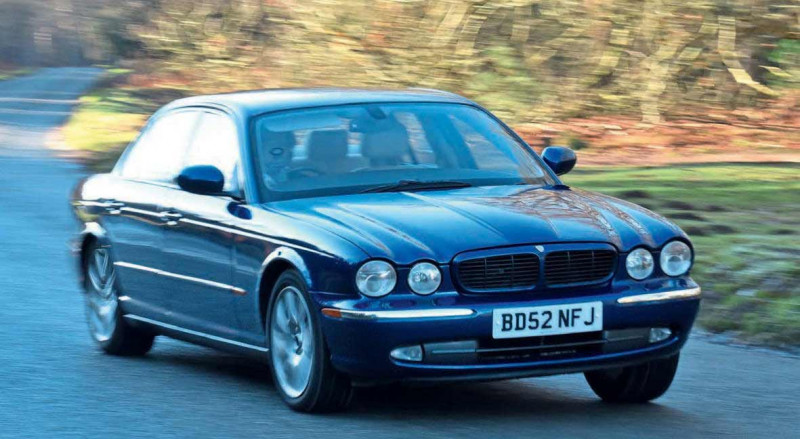
More intuitive than a mouse-driven system, this touchscreen would provide access to most of the car’s minor controls such as the radio and heater. Underneath, Jaguar employed an active suspension system to maintain a supple ride yet sharp cornering with air springs and dampers which could be adjusted in a matter of milliseconds – this Computer Active Technology Suspension (appropriately abbreviated to CATS) was designed to activate every 24 hours even when the car wasn’t in use, to level the vehicle.
Launched at the 2002 Paris Motor Show with a display incorporating a highly polished bare aluminium example, the X350 would be produced until 2007. It was succeeded by the X358 – a heavy facelift of the X350.
The BMW was widely acknowledged as the most technically audacious car in its class when new, to say nothing of being the first car in the world to use a six-speed automatic gearbox. iDrive changed the goalposts for in-car technology, even if today it feels old hat.
By contrast, the Jaguar’s touchscreen still feels like modern technology, and it’s certainly more intuitive. It might seem more old school on the surface, but by using aluminium technology and active suspension it offered clever technology where it counts.
This brings us to the choice you see before you – a choice which many period magazines felt was worth the assessment. BMW’s more sporting image means that the 745i was seen as a driver’s choice – seen here in long wheelbase 745Li form. The closest Jaguar in concept was the short-lived XJ8 Sport 4.2 – with just 190 produced, one of the scarcer and more interesting models, and by lucky coincidence Jaguar World’s project car since 2017. But which makes the more appealing classic prospect?
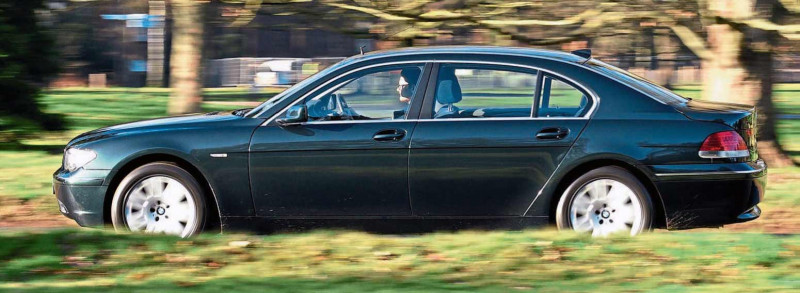
Both cars used their styling to draw in their intended market, but the early 2000s was a time of change. Ford’s New Edge look had sparked a move away from the soft curves of the Nineties toward a bolder appearance, and each car employs a different philosophy as a result of the shifting times in which they were created.
Jaguar’s X350 was arguably its most successful piece of new car styling in half a decade – the controversial S-TYPE and X-TYPE models had been criticised for being overly retro in outlook, and while Jaguar still harked back to its past for the X350 it was executed in a more contemporary manner.
The shell was higher than the outgoing model – the result of Ford managers insisting on additional headroom – but proportionally, there was almost an air of XJ Series 1 about the result. In Sport spec, the finish was contemporary – with chrome giving way to black and colour-coded trim. The chrome was also more muted on the XJ and Sovereign variants than it had been on the outgoing X308 – the overall air was of revision and evolution rather than change, despite the advances underneath the surface.
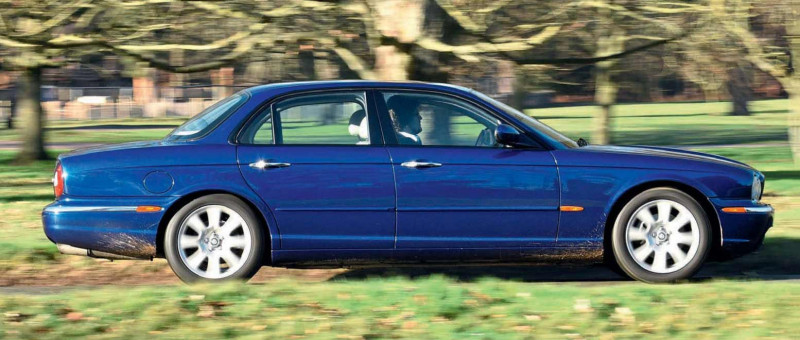
The BMW featured here looks oddly appealing in Oxford Green – the E65 7-series has aged remarkably well. It still won’t win any beauty prizes, but as modern cars have gained ever more questionable bulges and creases the 7 almost appears subtle eighteen years on from its introduction. While it’s far from Adrian van Hooydonk’s most coherent work for BMW, and certainly not his most appealing full stop, the E65 in a muted dark metallic has a grace denied to it by the ubiquitous silvers and greys which epitomised the era in which they were launched.
They appeal to very different tastes, then, but that’s not to say that either has a definite edge. Both still look imposing and tasteful today.
Inside, both cars continue their very different themes. Traditionally, Jaguar has used high contrast interior colour schemes and unusual veneers to give a younger, more up-to-date feel to its Sport models, and the Warm Charcoal and Ivory combination of this 4.2 Sport continues that theme. The almost grey bird’s-eye maple veneers cast a near monochrome effect over everything else, making the Ivory seats look far whiter than they actually are. Despite the room, Jaguar’s trademark sense of snugness remains, contributing to the feeling that the car shrinks around you. It’s all very special, despite being a standard specification. Not something we can accuse the BMW of. Check the VIN in any of a number of online decoders and you’d be forgiven for believing that this car had grey leather trim. However, at the request of first owner Sultan Qaboos of Oman, it was expertly retrimmed in blue velvet. This was not available as an option through BMW Individual, leading us to suspect this may be the only E65 not to have a full leather interior. The veneers – matt in finish – are cherry wood, taken from the BMW Individual range, and create an effect which is more contemporary than the Jaguar. However, the convex dash reinforces the sheer feeling of size from within, as does the centre console which seems to dominate the car. The column gear selector harks back to days gone by, and by moving control away from the centre console creates a greater illusion of size. iDrive feels excessively complex, though it does have the pleasant effect of reducing the number of buttons. A nice touch is the design of the dash vents, which can close completely in the manner of a venetian blind.
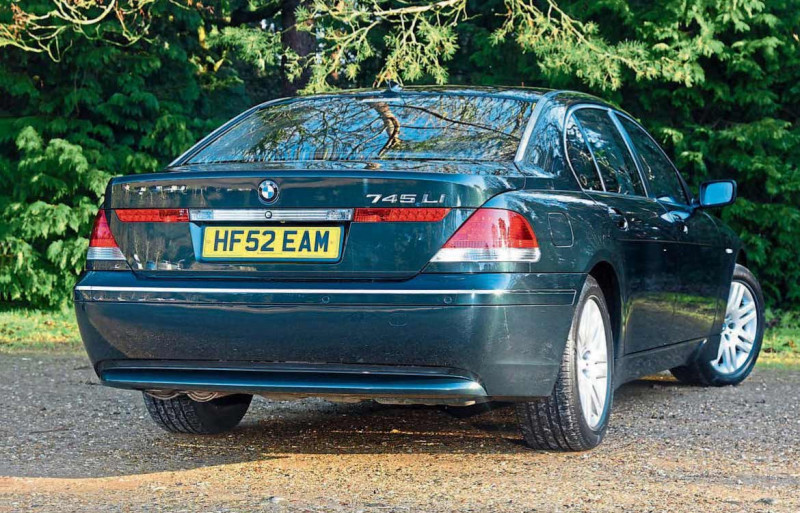
The first thing that strikes you with the Jaguar is just how light the doors feel, as you pull them shut. And this lightness remains apparent from behind the wheel. The Jaguar is 30bhp down on the BMW, but the weight saving of the Jaguar means that on paper it’s just as quick as its Bavarian rival. On the road, it feels more so – it feels smaller than it is, giving you the confidence to throw it about a bit and use all 300bhp where appropriate. It’s firmer than Jaguars of old courtesy of the CATS adaptive system and the Sport settings, but still perfectly cosseting once playtime is over and you settle into a sixth-gear cruise.
The BMW on the other hand feels compromised by its size and weight – like you’d have far more fun in a smaller car like the 545i. The steering is very nearly as slick as the Jaguar’s, but the extra weight and bulk makes it harder to place the car on the road with any degree of confidence. The thinner steering wheel rim encourages a more relaxed style of driving than the Jaguar, but the Tiptronic-style gear selector buttons on the steering wheel and the less serene ride feel at odds with this – it’s as if the BMW’s designers desperately wanted to make a sports saloon but were told it had to be an autobahn-stormer instead. Drivers of the BMW have little real cause for complaint. But if you want a capable sporting saloon, the Jaguar is a far wiser choice.
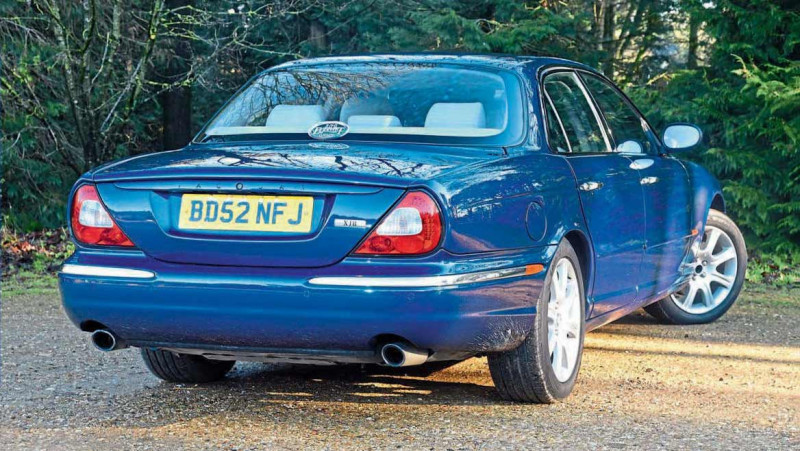
So if I were a wannabe plutocrat, which of these two luxury liners would find a place on my driveway? When both cars were new, the case for the BMW was strong – if you’re paying considerably north of £50,000 for a car, you’d like it to be something that your neighbours or competitors can admire, something that acts as a status symbol, and the Jaguar’s gradual evolution of its past appearance meant that many of those who didn’t understand cars simply might not notice the new purchase unless it was a different colour.
But we’re not spending £50,000, and it’s not the early 2000s anymore. These days it’s less important to impress your onlookers and more important to buy the old car that feels like a more coherent fit for you. And for me, that’s the X350. The BMW is technically audacious, and the fact that our car has clearly been specified to an individual taste makes it endearing – but it feels like a tool built to do a job. It doesn’t feel as personal as the XJ8, even if it’s more unusual.
I’d understand if you were to favour the BMW. But the Jaguar’s the one I want to take home.
Thanks to: Kim Cairns Classic Cars (www.kimcairnsclassics.co.uk) for the use of the BMW 745Li
Technical data 2002 BMW 745Li E66
- Engine 4,398cc 32v V8
- Max Power 330bhp
- Max Torque 332lb ft
- 0-60mph 6.4secs
- Top speed 155mph
- Transmission 6-spd auto ZF6HP
- Economy 24mpg
- Price new £60,000
- Value now £5k-£15k
Technical data 2003 Jaguar XJ8 Sport 4.2X350
- Engine 4,196cc 32v V8
- Max Power 300bhp
- Max Torque 310lb ft
- 0-60mph 6.6secs
- Top speed 155mph
- Economy 26mpg
- Transmission 6-spd auto ZF6HP
- Price new £51,500
- Value now £2k-£9k


